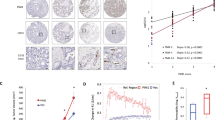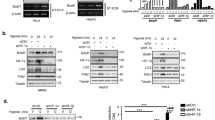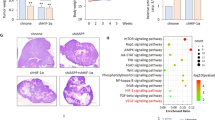Abstract
Hypoxia-inducible factor-1 (HIF-1) has a key role in cellular responses to hypoxia, including the regulation of genes involved in energy metabolism, angiogenesis and apoptosis1,2,3,4. The α subunits of HIF are rapidly degraded by the proteasome under normal conditions, but are stabilized by hypoxia5. Cobaltous ions or iron chelators mimic hypoxia, indicating that the stimuli may interact through effects on a ferroprotein oxygen sensor6,7. Here we demonstrate a critical role for the von Hippel-Lindau (VHL) tumour suppressor gene product pVHL in HIF-1 regulation. In VHL-defective cells, HIF α-subunits are constitutively stabilized and HIF-1 is activated. Re-expression of pVHL restored oxygen-dependent instability. pVHL and HIF α-subunits co-immunoprecipitate, and pVHL is present in the hypoxic HIF-1 DNA-binding complex. In cells exposed to iron chelation or cobaltous ions, HIF-1 is dissociated from pVHL. These findings indicate that the interaction between HIF-1 and pVHL is iron dependent, and thatit is necessary for the oxygen-dependent degradation of HIF α-subunits. Thus, constitutive HIF-1 activation may underlie the angiogenic phenotype of VHL-associated tumours. The pVHL/HIF-1 interaction provides a new focus for understanding cellular oxygen sensing.
This is a preview of subscription content, access via your institution
Access options
Subscribe to this journal
Receive 51 print issues and online access
$199.00 per year
only $3.90 per issue
Buy this article
- Purchase on Springer Link
- Instant access to full article PDF
Prices may be subject to local taxes which are calculated during checkout





Similar content being viewed by others
References
Wang, G. L., Jiang, B.-H., Rue, E. A. & Semenza, G. L. Hypoxia-inducible factor I is a basic-helix-loop-helix-PAS heterodimer regulated by cellular O2tension. Proc. Natl Acad. Sci. USA 92, 5510–5514 (1995).
Bunn, H. F. & Poyton, R. O. Oxygen sensing and molecular adaptation to hypoxia. Physiol. Rev. 76, 839– 885 (1996).
Carmeliet, P. et al. Role of HIF-1α in hypoxia-mediated apoptosis, cell proliferation and tumour angiogenesis. Nature 394, 485 –90 (1998).
An, W. G. et al. Stabilization of wild-type p53 by hypoxia-inducible factor 1α. Nature 392, 405–408 (1998).
Huang, L. E., Gu, J., Schau, M. & Bunn, H. F. Regulation of hypoxia-inducible factor 1α is mediated by an oxygen-dependent domain via the ubiquitin-proteasome pathway. Proc. Natl Acad. Sci. USA 95, 7987–7992 ( 1998).
Goldberg, M. A., Dunning, S. P. & Bunn, H. F. Regulation of the erythropoietin gene: evidence that the oxygen sensor is a heme protein. Science 242, 1412–1415 (1988).
Wang, G. L. & Semenza, G. L. Desferrioxamine induces erythropoietin gene expression and hypoxia-inducible factor 1 DNA-binding activity: implications for models of hypoxia signal transduction. Blood 82 , 3610–3615 (1993).
Warburg, O. The Metabolism of Tumours (Arnold Constable, London, ( 1930).
Hanahan, D. & Folkman, J. Patterns and emerging mechanisms of the angiogenic switch during tumorigenesis. Cell 86, 353–364 (1996).
Shweiki, D., Itin, A., Soffer, D. & Keshet, E. Vascular endothelial growth factor induced by hypoxia may mediate hypoxia-initiated angiogenesis. Nature 359, 843–845 (1992).
Kaelin, W. G. & Maher, E. R. The VHL tumour-suppressor gene paradigm. Trends Genet. 14, 423– 426 (1998).
Gnarra, J. R. et al. Post-transcriptional regulation of vascular endothelial growth factor mRNA by the product of the VHL tumor suppressor gene. Proc. Natl Acad. Sci. USA 93, 10589– 10594 (1996).
Iliopoulos, O., Levy, A. P., Jiang, C., Kaelin, W. G. J & Goldberg, M. A. Negative regulation of hypoxia-inducible genes by the von Hippel-Lindau protein. Proc. Natl Acad. Sci. USA 93, 10595–10599 (1996).
Dang, C. V. & Semenza, G. L. Oncogenic alterations of metabolism. Trends Biochem. Sci. 24, 68– 72 (1999).
Huang, L. E., Arany, Z., Livingston, D. M. & Bunn, H. F. Activation of hypoxia-inducible transcription factor depends primarily on redox-sensitive stabilization of its α subunit. J. Biol. Chem. 271, 32253–32259 ( 1996).
Wiesener, M. S. et al. Induction of endothelial PAS domain protein-1 by hypoxia: characterization and comparison with hypoxia-inducible factor-1α. Blood 92, 2260–2268 ( 1998).
Iliopoulos, O., Kibel, A., Gray, S. & Kaelin, W. G. J Tumour supression by the human von Hippel-Lindau gene product. Nature Med. 1, 822–826 (1995).
Salceda, S. & Caro, J. Hypoxia-inducible factor 1α (HIF-1α) protein is rapidly degraded by the ubiquitin-proteasome system under normoxic conditions. J. Biol. Chem. 272, 22642– 22647 (1997).
Pause, A. et al. the von Hippel-Lindau tumor-suppressor gene product forms a stable complex with human CUL-2, a member of the Cdc53 family of proteins. Proc. Natl Acad. Sci. USA 94, 2156– 2161 (1997).
Lonergan, K. M. et al. Regulation of hypoxia-inducible mRNAs by the von Hippel-Lindau tumor suppressor protein requires binding to complexes containing elongins B/C and Cul2. Mol. Cell Biol. 18, 732– 741 (1998).
Maxwell, P. H. et al. Hypoxia inducible factor-1 modulates gene expression in solid tumors and influences both angiogenesis and tumor growth. Proc. Natl Acad. Sci. USA 94, 8104–8109 (1997).
Zelzer, E. et al. Insulin induces transcription of target genes through the hypoxia-inducible factor HIF-1α/ARNT. EMBO J. 17, 5083 –5094 (1998).
Duan, D. R. et al. Inhibition of transcription elongation by the VHL tumor suppressor protein. Science 269, 1402– 1406 (1995).
Ohh, M. et al. The von Hippel-Lindau tumor suppressor protein is required for proper assembly of an extracellular fibronectin matrix. Mol. Cell 1, 959–968 ( 1998).
Wood, S. M. et al. Selection and analysis of a mutant cell line defective in the hypoxia-inducible factor-1 α-subunit (HIF-1α). J. Biol. Chem. 273, 8360–8368 (1998).
Fandrey, J., Frede, S. & Jelkmann, W. Role of hydrogen peroxide in hypoxia-induced erythropoietin production. Biochem. J. 303, 507– 510 (1994).
Iwai, K. et al. Iron-dependent oxidation, ubiquitination, and degradation of iron regulatory protein 2: implications for degradation of oxidized proteins. Proc. Natl Acad. Sci. USA 95, 4924– 4928 (1998).
Ho, V. T. & Bunn, H. F. Effects of transition metals on the expression of the erythropoietin gene: further evidence that the oxygen sensor is a heme protein. Biochem. Biophys. Res. Commun. 223, 175–180 (1996).
Chandel, N. S. et al. Mitochondrial reactive oxygen species trigger hypoxia-induced transcription. Proc. Natl Acad. Sci. USA 95, 11715–11720 (1998).
Gnarra, J. R. et al. Mutations of the VHL tumour suppressor gene in renal carcinoma. Nature Genet. 7, 85– 90 (1994).
Acknowledgements
We thank W. Kaelin, C. Buys and M. Lerman for cell lines, and N. Proudfoot, A.Harris, D. Gillespie, J. O'Rourke, Y.-M. Tian and L. Nicholls. Financial support was from the Wellcome Trust, the Barnes Trust, the Deutsche Forschungsgemeinschaft, the Cancer Research Campaign, Action Research and the Medical Research Council.
Author information
Authors and Affiliations
Corresponding author
Supplementary information
41586_1999_BF20459_MOESM1_ESM.doc
Length and sequence of riboprobe templates; HIF alpha subunit expression in renal carcinoma cells bearing VHL mutations; Hypoxic response element plasmids; Figure legend for figure S1 (DOC 22 kb)
Rights and permissions
About this article
Cite this article
Maxwell, P., Wiesener, M., Chang, GW. et al. The tumour suppressor protein VHL targets hypoxia-inducible factors for oxygen-dependent proteolysis. Nature 399, 271–275 (1999). https://doi.org/10.1038/20459
Received:
Accepted:
Issue Date:
DOI: https://doi.org/10.1038/20459
This article is cited by
-
HIF-2α/LINC02609/APOL1-mediated lipid storage promotes endoplasmic reticulum homeostasis and regulates tumor progression in clear-cell renal cell carcinoma
Journal of Experimental & Clinical Cancer Research (2024)
-
Targeting hypoxia-inducible factors: therapeutic opportunities and challenges
Nature Reviews Drug Discovery (2024)
-
Hypoxia induces mitochondrial protein lactylation to limit oxidative phosphorylation
Cell Research (2024)
-
Spatial functional mapping of hypoxia inducible factor heterodimerisation and immune checkpoint regulators in clear cell renal cell carcinoma
BJC Reports (2024)
-
CAND1 inhibits Cullin-2-RING ubiquitin ligases for enhanced substrate specificity
Nature Structural & Molecular Biology (2024)
Comments
By submitting a comment you agree to abide by our Terms and Community Guidelines. If you find something abusive or that does not comply with our terms or guidelines please flag it as inappropriate.



